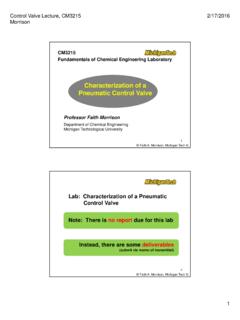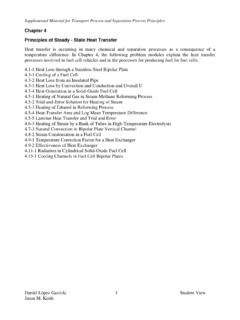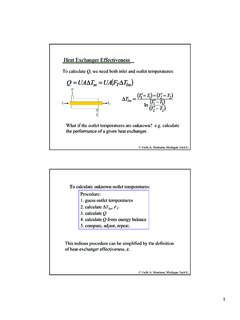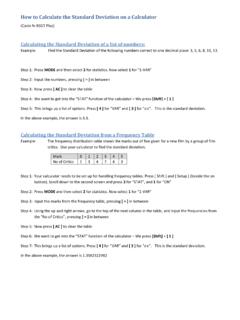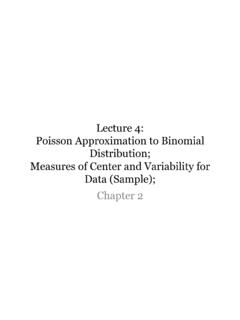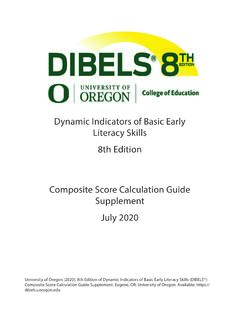Transcription of Lecture Notes on Statistical Methods
1 1 Lecture Notes on Statistical Methods (by Tom Co 9/23/2007, 10/15/2007) Charateristics of a Good Engineering Experiment 1. Necessity. a) objective is well formulated b) economical c) results are needed for decision, understanding and process improvement 2. Scope. a) significant variables are tested within important range b) (boundary and initial) conditions are properly set up c) results are representative of general case, scalable 3. Reproducibility and Statistical Significance a) enough trials need to be taken to assess confidence b) results must be reproducible for accuracy and precision of prediction 4.
2 Realization a) results can be applied to real process or system b) data are relevant to the real problem 5. Analysis a) Statistical analysis of data can and are applied b) the quality and confidence of the results including models are properly assessed General Concepts 1. Random Variable - a measured variable that takes on a range of possible values which are random ( lacking exact predictability) Two types of random variables: a. discrete Example: = number of ceramic rasching rings per cubic feet of absorption column b.
3 Continuous Example: = the void fraction per cross section area of the absorption column 2. (Statictical) Event - an occurence of the random variable taking on some specified values or range of values. Example: the number of ceramic rasching rings per cubic feet is greater than 200 200 2 Example: the void fraction per unit per cross section area is between and 3. Probability - The likelihood (normalized frequency) for the occurence of an event. Example: Pr Special case: When random variable is discrete, then discrete probability is the ratio of the [number of cases favorable to an event] to the [number of all possible cases] also known as the frequency of the event.
4 ( For a list of properties of probabilities, see Appendix 1. ) 4. Probability Distribution - a function ( or mapping ) of events to probabilities Motivation: Using historical data and experience (or assumptions), we want a convenient way to estimate or predict probabilities of events Methods : a. Using histograms o a grouping of collected data into categorized bins ( \ range of values) Figure 1. 3 Pr ( See Appendix 7 for details on using Excel to create histograms.) b. Using probability density functions ( pdf ) o a continuous approximation of a frequency histogram Figure 2.
5 Pr For a list of important probability distributions, see Appendix 2 and 3. o for discrete random variables, the function becomes the probability mass function (pmf) which has relevance only at the discrete points. Pr ( Examples of these are given in Appendix 2.) They are usually represented as a curve with dots at the discrete points; or, if the discrete random variables are spread evenly, the pmf can be represented by bar-charts. c. Using cumulative distribution functions (cdf) o a distribution that yields the probabilities of a one-sided range of random variables Pr 4 o For discrete random variables, the cumulative probabilities are given by Pr Measures of Central Tendency: Let and be the probability density function and probability mass function, respectively, of the population.
6 A) Population Mean ( Expected Value of x ) or b) Sample Mean ( Average ) Measures of Variability a) Population Variance: .. or Area = a a 5 .. b) Sample Variance: 1 The population standard deviation and sample standard deviation are given by and s, respectively.
7 Other Measures: i. Median: 50% of the population is less than the median point Pr ii. The first quartile ( 25th percentile) and third quartile ( 75th percentile ) can be used to identify outliers ( see appendix 6 for details ). iii. Mode: peak points of the probability distribution functions, 0 0 Some Important Properties: 1. The binomial distribution has: mean: = np and variance: 2 = np(1-p). 2. As n becomes large, the binomial distribution approaches a normal distribution 3.
8 The mean of a normal distribution is while the standard deviation is . 4. Define a new variable z, known as the standard scores, as .. If x is normally distributed with mean and standard deviation , z will follow a standard normal distribution with mean equal to zero and standard deviation equal to one. 5. Let x1, x2, .., xn be n samples taken independently from the same population with a fixed probability distribution, then the sum will approach a normal distribution as n approaches infinity.
9 6. In particular, the sample average, / , will be normally distributed with a mean equal to that of the original population. This is also known as the Central limit theorem. 6 7. Another result of the Central limit theorem is that the standard deviation of the distribution of the sample averages will be equal to .. (See Appendix 5 for derivation of this fact.) 8. If n is small ( <20), a correction to the Central limit theorem is to use a t-distribution instead, with degree of freedom, v=(n-1), where the t-scores are used instead of z-scores 9.
10 Let Y1, Y2, .., YN be independent N random variables, each following a standard normal distribution. Then the sum of squares given by will follow a Chi-square distribution with the degree of freedom, = N . (For every constraint imposed on the N random variables, the degree of freedom is reduced accordingly. For instance, if the sum of random variables has to be equal to a fixed number, say 120, then the degree of freedom is reduced by 1.) 7 Application 1: Generating Confidence Intervals for Sample Means Main Problem: - The sample mean is supposed to estimate the population mean.
